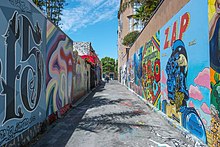Clarion Alley

Clarion Alleyis a small street between Mission and Valencia Streets and 17th and 18th Streets in theMission DistrictinSan Francisco,California. It is notable for the murals painted by theClarion Alley Mural Project.[1]
History
[edit]Originally called "Cedar Lane," the alley's name was changed around the turn of the twentieth century to Clarion Alley.[2]The street is notable for community and arts activity, including theClarion Alley Mural Project,the American Indian Center[3]and Promotoras Latinas Comunitarias de Salud.[4]
47 Clarion
[edit]The warehouse at 47 Clarion was originally known as the Woodmen Building with the main door at 3345 17th Street. It was anIWWmeeting hall, whereTom Mooneyonce attempted to organize railway workers.[5][6][7]Later, it was home to artists and musicians from at least the early sixties through 2002.[8][9]Notable residents includedTerry Riley,The Cockettes,Lise Swenson ofArtists' Television Access,and two of the artists,Rigo 23and Aaron Noble, who were founding members of the Clarion Alley Mural Project. 47 Clarion was demolished in 2001, and a parking lot for the condominium project on 17th Street replaced it. It became a symbol of the neighborhood'sgentrification.
Murals
[edit]Since 1992, the alley has been covered in murals painted by theClarion Alley Mural Project.Alley residents Noble and Rigo together painted the mural "Superhero Warehouse" showing a series of depressed superheroes on the warehouse's side, as a contribution to the mural project. Another of the early murals, painted byScott Williamsafter research done byFred Rinne,depicted native animals of the Mission District.
Dog Days
[edit]Clarion Alley was featured in the opening chapter of the fiction novelDog Daysby John Levitt. The main character is ambushed by evil forces that animate one of the murals into a monstrous force.[10]
References
[edit]- ^"Clarion Alley Mural Project Turns 25: A Historical Primer: SFist".SFist.2017-10-20.
- ^Sanborn Maps, SFPL[which?]
- ^"Clarion Alley and Post-modernism".FoundSF.Retrieved2013-09-22.
- ^"Dot Meltdown Real Estate Frenzy Subsides at end of 2000".FoundSF. Archived fromthe originalon 2019-03-27.Retrieved2013-09-22.
- ^"The Epicenter of Crime: The Hunt's Donuts Story".FoundSF.Retrieved2013-09-22.
- ^Curt Gentry,Frame-up; the incredible case of Tom Mooney and Warren Billings.Norton 1967
- ^Crocker Langley City Directory 1920
- ^"Clarion Alley Mural Project Turns 25: A Historical Primer".SFist.Archived fromthe originalon 2017-11-24.Retrieved2018-09-14.
...as the original 47 Clarion space that served as his home and studio was demolished in 2002.
- ^"Projects".Megan Wilson. Archived fromthe originalon 2017-10-13.Retrieved2013-09-22.
- ^Levitt, John (2007).Dog Days.Penguin Group. pp.1–3.ISBN9780441015535.
Bibliography
[edit]- Murray, Julie. "Moving Stairway to Heaven" inStreet Art San Francisco: Mission Muralismo,Jacoby, Annice, ed. NY: Abrams, 2009. p 126
- Noble, Aaron. "The Clarion Alley Mural Project" p. 113 and "Vatos Mexicanos Locos" p. 122 inStreet Art San Francisco: Mission Muralismo,Jacoby, Annice, ed. NY: Abrams, 2009
- Rapoport, Lynn (October 23, 2002)."Wall space: The Clarion Alley Mural Project uses public art to paint a home".San Francisco Bay Guardian.Retrieved2013-09-22.


